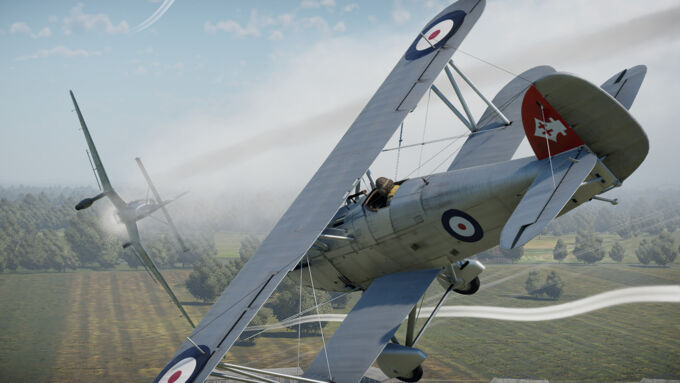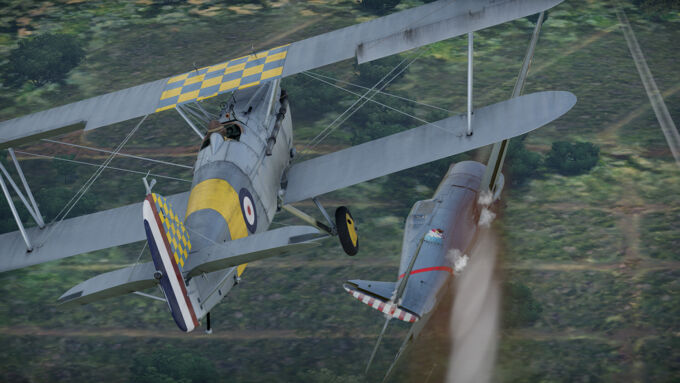The Fury and its carrier-based version, the Nimrod, are part of a family of biplane fighters found in the British aviation tech tree. With a similar flight performance to biplanes of other nations and a generous ammunition pool, the Fury is a great plane to introduce newcomers to the British tech tree.
Pros and Cons:
| Pros | Cons |
| The Nimrods can land on and take off from aircraft carriers. | Weak offensive armament. |
| Reasonable amount of ammunition available. | Monoplanes can outrun it. |
| Fuel tanks are self-sealing, increasing survivability against fires. | No armour protection. |
Table of Contents:
Note: The information in this article prioritises performance of the vehicles in Realistic Battles. The vehicles' performance may differ in Arcade or Simulator Battles.
Survivability:
The Fury and the Nimrod’s survivability is comparable to that of other biplanes. They have no armour and the pilot sits in an open cockpit, making them vulnerable to enemy fire. The fuel tanks are self-sealing, however, which increases your chances of survival in case they are set on fire. Featuring an inline engine instead of a radial one, the odds of these biplanes losing it due to enemy fire are also lower. Overall, the airframes are quite fragile so avoiding enemy fire is recommended.
Flight Performance:
As mentioned in the introduction, these fighters have a similar flight performance to biplanes of other nations. All variants of the Fury and of the Nimrod behave similarly. With a maximum speed of 394 km/h, though the Nimrod is slightly slower, they can outspeed some contemporary biplane designs such as the J6B and the I-15bis, as well as early monoplanes like the D.500 or the P-26 Peashooter. However, the Fury and the Nimrod can also face faster monoplanes which have no problem outrunning it, for example the Bf 109 B-1 and the P-36A.
Being biplanes, the Fury and Nimrod have a short turn time which allows it to out-turn less agile opponents such as the aforementioned monoplanes that are faster than you. The wing configuration also provides them with a fairly decent rate of climb and makes it easy to control them at low speeds. This trait is particularly useful for the Nimrod, which can land on aircraft carriers thanks to the addition of a tailhook. The lower the speed of your approach, the easier it is to land on a carrier.
Armament:
The offensive armament is pretty poor, consisting of two 7.7 mm Vickers E machine guns with a total of 1200 rounds of ammunition and four different belts. Using the “Tracers” belt is not advised due to the lack of amour-piercing and incendiary bullets. Instead, it is recommended to use either the Universal or Stealth belts. Due to the fact that you have to rely on two low-calibre machine guns, it would be wise to aim for weak spots such as engines, pilots or wings in order to bring down enemy aircraft without wasting much ammunition.
Usage in Battles:
The Fury and the Nimrod are excellent biplane designs which balance agility, speed and rate of climb, providing them with a satisfactory flight performance. Their armament, while not outstanding, is enough to deal with most of the opposition that they find, but heavier targets such as bombers should be left to allies with stronger offensive weaponry.
Air Battles:
In air battles, the Fury and the Nimrod are played as a traditional biplane fighter, using its agility to out-turn faster opponents while outrunning the occasional slower ones. When dealing with opponents whose agility is superior to yours, avoid turn fighting them. Examples of such opponents are the I-15 family of biplanes, with the reserve variants being among the aircraft that turn the fastest in the game. Against these opponents, try to attack them when they are distracted by using tactics such as Boom and Zoom. Position yourself higher than the enemy, dive and shoot it down. Do not follow the enemy plane if it turns away! Regardless of whether you succeeded or not, gain altitude again to avoid being chased and repeat the process.
Against faster opponents who are less agile than you, try to bait them into a turnfight in which you will come out as the winner thanks to your shorter turn time. Position yourself behind the enemy and shoot at it. If the enemy plane is faster and runs away, don’t bother chasing it. Instead, turn away, prepare for a possible counterattack, and keep baiting him into a battle that he can’t win.
Mixed Battles:
These fighters have limited use in mixed battles, be it ground or naval. Lacking any type of suspended armament, it is unable to provide close air support, meaning that it should instead patrol the skies and shoot down enemy aircraft that can pose a serious threat to your allies if not dealt with.











